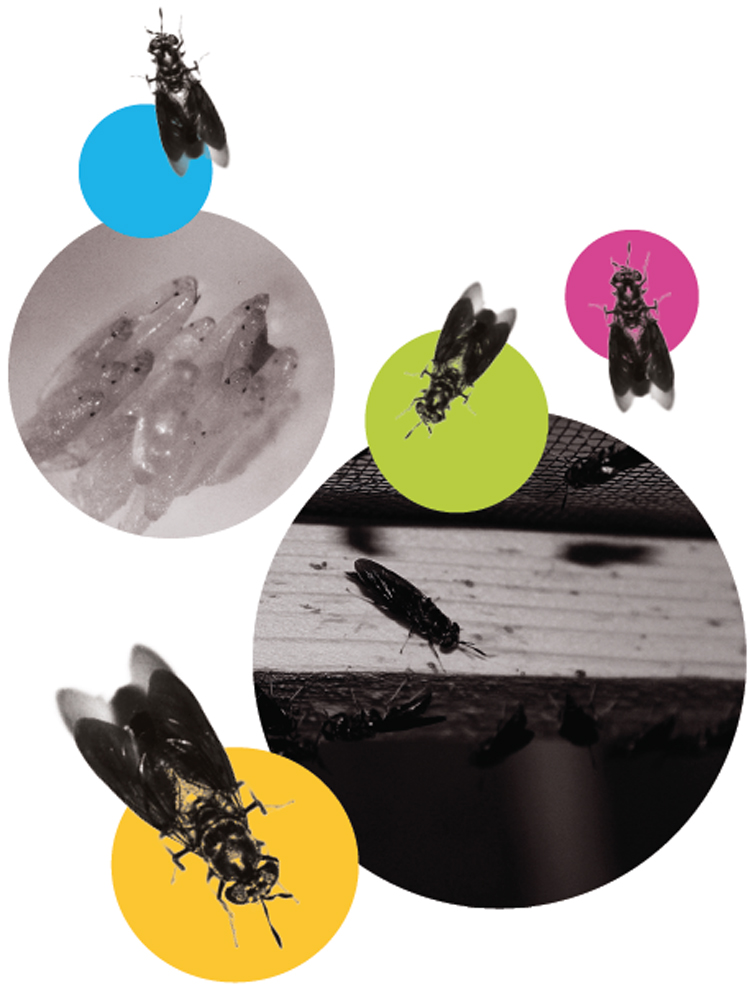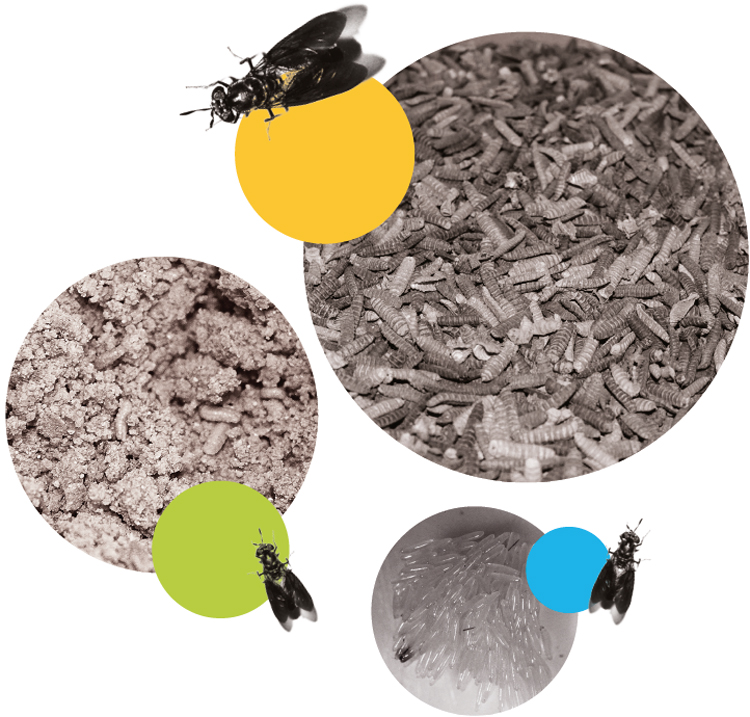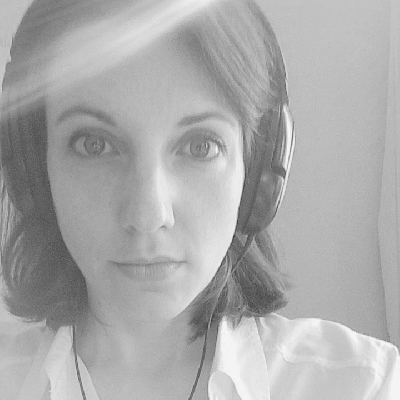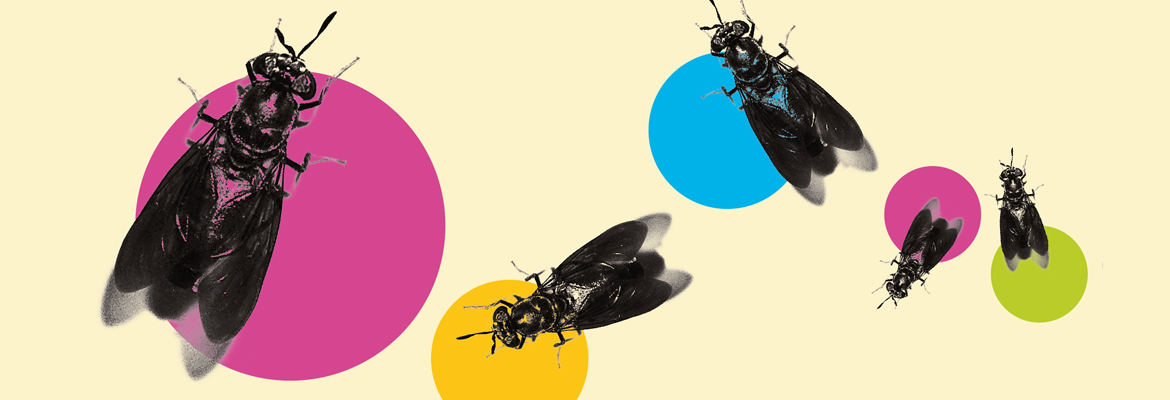Disposing of waste thanks to a fly and producing feeds out of it. This is the objective of the “Insect Bioconversion” project, a study on the use of a fly – Hermetia illucens – for disposing of fruit and vegetable waste. Such insect, once grown with this special diet, is used to obtain flour with a high protein content used to supplement feeds used for farmed fish.
The “Insect Bioconversion” project presented at the University of Insubria in collaboration with the University of Milan and Crea – Council for research in agriculture and analysis of agricultural economy – in Padua was granted €300,000 by Fondazione Cariplo within the competitions activated for the “Integrated research on industrial biotechnologies and the bioeconomy”. It was also endorsed by Sogemi Spa, a company for the creation and operation of the wholesale food markets in Milan, by the Association of Italian fish farmers and Paul Vantomme, in charge of FAO’s “Edible Insects” project.
The research is organized in five stages. First of all, the growth performance of Hermetia is taken into consideration with different kinds of diets: from a standard one made of bran, corn and alfalfa, to a chicken feed, typically used to feed other types of insects and a vegetable diet still being studied.
The second stage is about the biological characterization of Hermetia, that is the detection of some markers to assess the growth performance, its efficiency in the transformation of the substrate and the conditions in which this insect grows (optimal or potentially pathogenic). During this phase, a selection of the best subjects takes place so as to create an egg stock of Hermetia, necessary to start a certified supply chain in the post-research stage.
During the third stage, the fly is isolated from what remains of the substrate, then the transformation of the insect in flour and its microbiological evaluation. Then tests on rainbow trout are carried out, phasing in insect flours into traditional feeds, analysing the growth performance and the wellbeing of the fish fed in this way.
The last step is the evaluation, the study and management for alternative uses – as compost or development of soil conditioners to be used in nursery gardening – of non consumed waste, together with insects’ faeces and chitins derived from ecdysis.

From an Idea to the Project
The project manager in Varese is Gianluca Tettamanti, an entomologist. We met him in his laboratory.
“There is still a lot to discover about Hermetia Illucens: at the moment, we are assessing on a small scale the growing phase and we saw how, by changing, even slightly, lighting, temperature and humidity, the impact on the life cycle is dramatic”, explains the professor. “This insect has excellent characteristics for our project. It is saprophagous, meaning that it grows on decomposing material. Its yield is really high for the amount of waste it is able to dispose of. And, more importantly, an adult lives up to a few days only and after laying eggs it dies. Therefore, unlike other more studied insects, it does not carry any diseases. Undoubtedly, this is an advantage for the research.”
Tettamanti then tells how the project was born. “The interest of the work group towards edible insects dates back to 2013, when in Europe such interest started. Simultaneously, the aquaculture colleagues stressed the need, in a rapidly expanding economic sector, to find efficient systems to provide protein for farmed fish. In the same period, through contacts with Sogemi Spa by Roberto Valvassori, a zoologist and back then full professor at Insubria, we got to know about the need of society to dispose of 1,300 tonnes of fruit and vegetable waste every year.”
So, we developed the idea to transform such waste into a resource, enhancing the potential of an extremely topical subject, edible insects, reacting at the same time to the needs of a very promising sector for Europe, aquaculture.
Not only that. As a matter of fact, other companies as well need to dispose of substrates, perhaps different ones, beer waste for instance. At the moment, such waste is used to produce biogas or is composted: using it to feed insects could instead represent a valid alternative. Actually, the insect is not just a source of protein, although the percentages of such component vary between 30-60%. For example, the oil fraction, besides for animal feed industries, it could prove useful for the cosmetic sector. Chitins and chitosans – that is the part constituting the exoskeleton left over the substrate during ecdysis – are used for packaging in the food industry, since they seem to stimulate the immune system. Last but not least, Hermetia can provide us with antibacterial molecules.
However, in order to achieve all this, large-scale protocols are needed as well as standards to develop a certified production chain. The question of standards is key in the research: in Europe the limits in insects’ farms for animal feeding not only have repercussions on efficiency but also on health risks. Just a few months ago, EFSA – European Food Safety Authority – published a report where this theme is debated, raising doubts on the potential biological and chemical dangers, but also allergenic issue and environmental risks linked to the use of insects farmed for food and feed.

Aquaculture: The Choice that Makes all the Difference
Today, according to the available data, aquaculture provides about 50% of fish products for human consumption worldwide; while in Europe it represents 24% of fish production, with 85,000 jobs. Indeed, the European Union has been promoting this sector for over 15 years, with ad hoc funds, highlighting the sustainability of farmed fish products and stressing the fact that aquaculture is one of the most rapidly expanding sectors at global level. For this reason, faced with the choice of the end use of the insect flour obtained with the project, we thought of fish farming. Moreover, such farmers need standard feeds to keep the fish growth performance high, while warding off possible diseases and the reduction of the end fish production.
Genciana Terova will carry out the test on fish with the flour from flies. She is in charge of the aquaculture sector of the Department of Biotechnologies and Science of Life at the University of Insubria. Even though the research phase involving her has not started yet, we would like to have a closer look at the project with her.
We immediately discover that the choice to test the flour on the rainbow trout depends on the fact that in Lombardy there is a huge fish production, of trout in particular: the region hosts over 70 fish farms and over 5,000 tonnes of fish are produced each year. We also found out that the insect flour could be compatible – after all due experimental evaluations – with other carnivorous species, such as bass, carp or tilapia.
Genciana Terova explains to us that, actually, the best source of protein for farmed carnivorous fish is fish flour. However, in order to keep economic and environmental sustainability, this is usually and largely replaced by plant-based flours, which are not always digestible and are often associated with anti nutritional factors. The possible advantages for fish represented by the use of Hermetia flour should be linked to the fact that such flour is a digestible protein source. If such hypothesis is confirmed, fish will be able to benefit from an animal protein source, which can be easily digested and does not cause inflammation to the digestive system.
Locusts, crickets and larvae on the table? Let’s hear it from EFSA
EFSA is the European authority for food security: not only does if provide scientific consultancy but also efficient communication about risks – existing and emerging – associated with the food chain. In October 2015, it released a report entitled Risk profile of insects as food and feed where it is stated that insects represent a niche food sector in the European Union, although many member states reported occasional human consumption.
However, the use of insects as source of food and feed has, potentially, important benefits for the environment, the economy and the security of food availability.
In its report, EFSA highlighted that the possible presence of biological and chemical hazards in insect-derived food and feed products depends on many factors: on production methods, on what the insects are fed (the so called substrate), from the phase of the life cycle in which insects are collected, on the species used as well as the methods used for their ensuing transformation.
By way of conclusion, when the non-processed insects are fed on feeds that are not currently authorized, the potential onset of microbiological hazards is understandably similar to that associated with other non-processed protein sources. The risk factor, is linked to the use as substrate of human or ruminant faeces, which is what led in 2001 to the ban of mammal meat and bone flours in all feeds for farmed animals in the EU, because of a link between such flours and the spread of BSE (Bovine Spongiform Encephalopathy) in livestock due to an association between the BSE-infected meat and the variant of Creutzfeldt-Jakob disease in human beings. EFSA’s scientific opinion takes also into consideration other hazards associated with other kinds of substrate, such as kitchen waste and manure. What we need to do, though, as stated in the report, is to carry on with the research in such fields, in order to avoid chemical risks too (for instance the build-up of heavy metals and toxins) or biological risks (bacteria, viruses).
Efsa Report Risk profile of insects as food and feed, www.efsa.europa.eu/sites/default/files/scientific_output/files/main_documents/4257.pdf
From Waste to Resource
In the near future, the real challenge will be to be able to feed an ever-growing world population with increasingly dwindling resources.
Insect farming could well close the gap in two differing ways: by introducing in human food insect consumption which today already represents a protein supplement for over two billion people, but that should overcome many people’s resistance, at least in Europe. The second possibility is about the use of insects to supplement animal feeds with a very low environmental impact compared to that linked to their production with fish flours. The “Insect Bioconversion” project, therefore, is not only a bioeconomy project. What makes it so alluring are the enormous applicability and environmental sustainability of such continuous transformation, of re-cycling renewable raw materials (vegetable substrate and insects), contributing at every level to change the very idea of development.
“Insect Bioconversion” Project, tinyurl.com/jda34cx
“Edible Insects” Project, www.edibleinsects.it
Info
www.fondazionecariplo.it/it/index.htmldipbsf.uninsubria.it/invertebrati/



